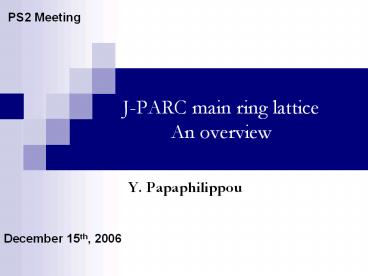J-PARC main ring lattice An overview - PowerPoint PPT Presentation
Title:
J-PARC main ring lattice An overview
Description:
... scraper collimators and beam dump Slow resonance extraction for K-ARENA (Nuclear and Physics ... Length 0.7 m Number 72 Quadrupole Magnet (11 families ... – PowerPoint PPT presentation
Number of Views:74
Avg rating:3.0/5.0
Title: J-PARC main ring lattice An overview
1
J-PARC main ring latticeAn overview
PS2 Meeting
- Y. Papaphilippou
December 15th, 2006
2
J-PARC Project
- Japan Proton Accelerator Research Complex
comprising - A 600-MEV linac with a superconducting section
for nuclear transmutation RD - A 3GeV Rapid Cycling Synchrotron (RCS) for a
spallation neutron experimental area - A 50GeV Main Ring (MR) for nuclear physics and
neutrino experiments
3
Main Ring layout
- 1567.5m long ring with triangular shape
- Three 406.4m long arcs using a missing bend cell
structure - Three 116.1m long straight sections with
- Injection from the 3GeV RCS, scraper collimators
and beam dump - Slow resonance extraction for K-ARENA (Nuclear
and Physics studies facility) - RF and fast extraction for neutrinos to
SuperKamiokande
4
Main Ring parameters
Parameter J-PARC PS2
Circumference m 1567.5 1257
Injection energy GeV 3 3.5
Extraction energy GeV 50 50
Particles per pulse 1013 33 3.2 - 13
Repetition rate Hz 0.3 0.21 - 0.42
Circulating current _at_ injection A 12.4 1.2 - 4.8
5
Main Ring lattice
- Design criteria
- Imaginary ?t
- Long dispersion free straight sections to
accommodate injection extraction RF and
collimation - Reasonable tuning range for tunes chromaticity
and momentum compaction factor - 3 super-periods
- Arc Insertion
- Working point of (22.25, 22.23)
6
Main Ring lattice - arc
- Eight 50m-modules per arc
- 32 dipoles (5.85m), 4 families of 57 quadrupoles
(1.26-1.86m) - Module of 3 FODO cells
- (1/2D)BFBDOFODBFB(1/2D)
- Central half-cells without bend
- Split central QF for sextupole accommodation
- ac of -0.001 (imaginary ?t of 31.6i)
- Reasonable ß and ? maxima (35m, 3m)
- Horizontal and vertical phase advance of 3p/2,
giving a total of 12p - Dispersion free straights, first order
cancellation of sextupole resonance, - Vertical phase advance tunable down to 200o to
avoid coupling resonance
7
Main Ring lattice Insertion
- 3 central FODO cells of 50m with doublet
matching section in either side - 7 families of 15 quadrupoles (0.9-1.76m)
- FODO cells used for adjusting phase advance and
collimation system - Long half-cell for injection, beam dump and
extraction - Short half-cell, where ß is maximum and a almost
0 for slow extraction electrostatic septum
8
Tune optimization
- Horizontal tune optimized varying insertion phase
advance - Slow extraction devices fixes the phase relation
among and reduces flexibility (tune of 22.33). - Without slow extraction constraint, tune range
between 21.50 and 22.80. - Vertical tune can be almost freely chosen in the
range of 17.25 to 22.25 - Using mostly the arc and less the insertion.
- Structure resonances to be avoided 2?x2?yn,
2?x-2?yn ?x22.5, ?y18, 19.5, 21, 22.5
9
Momentum compaction knob
- Lattice can be tuned for a range of ac between
0.002 and -0.002 (?t of 21 to 21i), varying
the vertical phase advance as a knob - Reasonable maxima for all optics functions
- Extrapolating to the desired ac value for PS2
(-0.02) not evident
10
Main magnets
- Bending Magnet
- Bending Radius 89.381 m
- Field 0.143 T (for 3 GeV), 1.9 T (for 50 GeV)
- Useful Aperture (horizontal) 120 mm
- Gap Height 106 mm
- Length 5.85 m
- Number 96
- Sextupole Magnet (3 families)
- Max. Field Gradient 230 T/m2
- Aperture 136 mmf
- Length 0.7 m
- Number 72
- Quadrupole Magnet (11 families)
- Field Gradient 1.35 T/m (for 3 GeV)
- 18 T/m (for 50 GeV)
- Aperture (pole to pole) 130 mm
- Useful Aperture (horizontal) 132 mm
- Length and Number
- QDN, QFR and QDR 1.86 m (63)
- QDS 1.76 m (6)
- QDX and QDT 1.66 m (33)
- QFN 1.56 m (48)
- QFT 1.46 m (6)
- QFX and QFS 1.26 m (54)
- QFP 0.86 m (6)
11
Preliminary comments
- J-PARC module very similar to PS2 preliminary
lattice design (J.Jowett) - Same length, number of cells, magnets, similar
phase advances - Main difference DOFO structure (instead of
FODO), and single dipole - Large imaginary (or real) transition energy
- 20 longer ring just by giving the appropriate
space to straight sections - Decreasing ac pushes quadrupole strengths and
optics functions to their limits and may
necessitate a longer ring - Independent insertion tuning gives enormous
flexibility for injection, extraction collimation
and RF optics constraints - Without the momentum compaction constraint,
ability to optimise the phase advance for 1st
order cancellation of lattice non-linearities































